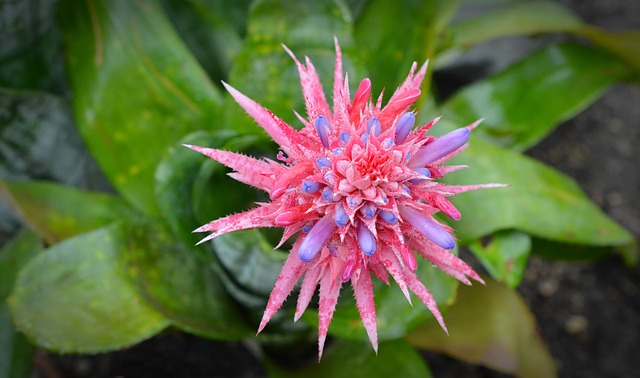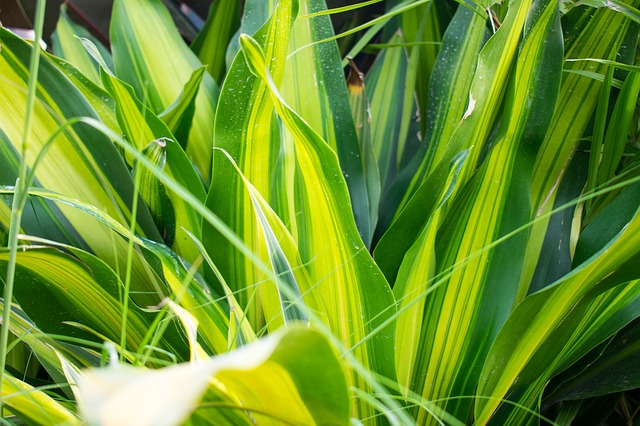The west-facing window is a tricky place to grow plants. It may be a little too sunny or a little too dark for plant growth. But with some careful planning, it can be an ideal spot for lush, green growth. This article covers our top selection of plants for west-facing windows.
Why should you grow plants in your west-facing windows? – In the morning, the light from the window will hit your plants from the side and provide more indirect light than direct sunlight. In the evening, your home’s west-facing windows will catch sunset light and illuminate your house with warm colors.
There are many different plants that can grow well in this type of environment, but we’ve narrowed it down to our 14 favorites:
Best Plants for West-facing Windows
1. Aechmea Fasciata (Urn Plant)
Aechmea fasciata is a plant that can take on a number of different shapes, depending on the environment in which it grows. When grown in the shade, it usually takes on an upright, columnar appearance. When grown in full sun, it usually takes on a more spreading shape. This is the reason, we believe this is the #1 best plant for west facing windows.
Aechmea fasciata is commonly called urn or cigar plant due to its shape when it is grown in full sun. This type of growth pattern provides protection from the harsh rays of the sun and offers some natural cooling as well as protection from high winds and heat.

2. Aphelandra Squarrosa (Zebra Plant)
This is a plant that is known for its ability to thrive in west-facing locations. It’s also called the Zebra Plant, because of the zebran stripes on its leaves. The Aphelandra squarrosa grows up to 5 feet tall and has an average life span of 10 years. It thrives best under low light conditions and can grow well with little water.
This plant is commonly used as a decoration plant for offices, stores, restaurants, and other commercial establishments. The Aphelandra squarrosa has been seen as a way to reduce stress in the workplace by providing places for employees to take breaks from their computers or work areas.
3. Araucaria Heterophylla (Norfolk Island Pine)
Araucaria heterophylla (Norfolk Island Pine) is a species of coniferous tree in the family Araucariaceae. It is native to Norfolk Island and Lord Howe Island in the Pacific Ocean.
The Norfolk Island Pine is the tallest of its genus, growing to heights of 50 meters with trunk diameters up to four meters. It has long, slender leaves that are up to six centimeters long with a distinct drooping tip. The flowers are small and greenish-yellow in color.
4. Chamaedorea Elegans (Parlor palm)
West-facing plants are an excellent choice for an indoor garden. If you live in a place with extreme climates, you should make sure that all of your plants are south-facing. However, if you live in a temperate climate and have the ability to offer your plant some protection from the sun, west-facing plants can be an excellent choice.
The Chamaedorea elegans is a well-known and popular houseplant to many people because it is easy to take care of and doesn’t need much water or sunlight.
5. Cordyline terminalis (Ti Plant)
Cordyline terminalis is a one of our selected plants for west-facing windows and is often used for landscaping purposes.
Cordyline terminalis (Ti plant) is a great west-facing plant. It should be planted outside and to the left or right of the door, as it thrives best in bright, indirect light.
It should be watered every week and fertilized twice a month during its growing season (spring and summer). The Cordyline terminalis (Ti Plant) will need to be watered more often than other plants because it dislikes wet feet and will not do well if left underwater for long periods of time. Ti plants should be repotted yearly in order to take advantage of their fast growth rate
6. Crassula Ovata (Jade Plant)
The jade plant is a popular houseplant because of its ability to thrive in low light. The west-facing exposure of the window is perfect for this plant, which is native to South Africa.
The Jade Plant is a succulent that can survive with little water or fertilizer, making it perfect for those who are not able to maintain their plants, as well as they would like.
7. Cypripedioideae (Lady’s Slipper Orchids)
The Cypripedioideae, Lady’s Slipper Orchids, are a monotypic family of plants that are typically west-facing and grow in temperate regions.
Lady’s slipper orchids, also known as “Cypripedoideae,” are a monotypic family that typically grow in temperate regions and is typically west-facing. These plants are unique because they contain the world’s only known seedless vascular plant – they are the only vascular plant on earth with no seeds.
Lady’s slipper orchids are known to produce the world’s largest unbranched sorus, which is made up of up to 300 individual flowers. They can reproduce via both sexual and vegetative means and can sometimes be found in other colors besides pinkish-white.
8. Dieffenbachia (Dumb Cane)
Dieffenbachia is a genus of the arum family. Its name comes from J.F. Dieffenbach, a German botanist who discovered and named the plant in the late 18th century.
Dieffenbachia plants are often grown in homes and offices to create an oxygen-rich environment or for their ornamental qualities. They can be both high-maintenance plants and low-maintenance plants depending on the type of location they are placed in and how much care is given to them.
9. Dracaena Fragrans (Corn Plant)
The Dracaena plant is a houseplant that thrives in bright, indirect light. They prefer to grow in a west-facing window, but they can also grow in east-facing windows.
Corn plants are easy to grow, low maintenance plants that are often overlooked. This article will explore the best ways to care for your corn plant.
The plant is also known as Dracaena fragrans, Corn Plant, Ribbon Ease Plant, Striped Dracaena. The striped Dracaena is a houseplant that has been popular in the United States since the 1950s. It’s most popular for its striped leaves that can grow up to 16 feet long with a width of 3 inches.

10. Echinopsis (Hedgehog Cacti)
Echinopsis is a genus of cacti. It includes the species commonly known as Hedgehog cactus or Echinopsis Pachanoi.
In the past, these plants were primarily found in Chile, Peru, and Ecuador. In recent years, they have become more popular in cultivation in other regions of the world, such as California and Spain. The USDA has classified them as “USDA hardy to zone 8”.
11. Faucaria tigrina (Tiger Jaws)
Faucaria tigrina is a west-facing plant that is native to South Africa. It has been known by many names including Tiger Jaws, Dragon’s Mouth and Tiger Teeth. It lives in the dry, rocky regions of Southern Africa. The plant has a long period of dormancy in the summer months.
The Faucaria tigrina is a small succulent plant with triangular leaves that are arranged in pairs at right angles to each other. The leaves are reddish-purple on the outside and have black spots on them when they are young, but they turn green as they age. The flowers are bright yellow-orange-colored tubular flowers that are densely clustered near the base of the stem. They have a light, pleasant fragrance that can often be detected before one is even close enough to see them.
12. Hibiscus rosa-Sinensis (Chinese Hibiscus)
Hibiscus rosa-sinensis, or the Chinese Hibiscus, is a plant native to China. It’s been used in traditional Chinese medicine for centuries. In Eastern cultures, it’s been used to treat anxiety and depression. The leaves and flowers of this plant are typically consumed as tea and steeped in hot water for up to ten minutes before being cooled and drank with the use of an infuser.
13. Mammillaria Elongata (Gold Lace Cactus)
Mammillaria elongata (Gold Lace Cactus) is a west-facing plant that does well in pots and containers and can be grown in the sun or shade.
The Gold Lace cactus is a west-facing plant that does well in pots and containers, but it can also be grown in sun or shade. It grows up to 8 inches tall. The Gold Lace Cactus is the sole species of the genus Toumeya, which can make it fairly easy to identify from other types of cacti. The name comes from the bright gold flecks that show up on its skin, often a sign that it’s mature and ready for harvesting. The Gold Lace Cactus is a fairly slow-growing type of cactus, but they are capable of growing to be quite large
14. Saxifraga Stolonifera (Strawberry Begonia)
Strawberry Begonia is a perennial plant associated with the west-facing aspect in gardens.
The plant is native to South Africa but has been introduced to other parts of the world. It gets its name from the strawberry-like scent that it emits when rubbed or crushed.
It produces clusters of white flowers that will bloom during the summer months.
The Strawberry Begonia is generally treated as an annual in colder climates due to its small size
While this plant thrives with moisture, it can also survive in dry climates when given supplemental water or humidity.
This plant, which relies on the cold and dark of winter to become dormant and enter a state of dormancy, can be forced into growth and could even be used as a houseplant by someone with the right knowledge and care. These plants can be replanted in pots for indoor use over the cold months, or they can be left outdoors where they will become dormant.
West-Facing Windows Plants FAQ
Q: What plants do well in a West-facing window?
A: Plants that thrive in low light but need protection from the hot midday sun can do well in a West-facing window. These plants include jade plants, peace lily, and English ivy.
Q: How much light does a west-facing window get?
A: The amount of natural light a west-facing window receives varies with the seasons. In winter, when the sun is positioned in relation to the Earth at a low angle, it will shine through a west-facing window for long periods during the day. In summer, when the sun is positioned in relation to the Earth at a high angle, it will be more difficult for light to reach through these windows in
Q: Is a west-facing window a good choice for a Monstera Siltepecana?
A: Every plant has different requirements and needs, and windows can help or hinder a plant’s growth depending on how they’re positioned. A west-facing window will produce bright light and heat and can dry out the air much quicker than other window orientations. This is great for plants that need more light, but not so great for those that need less.
Q: Is the Calathea Ornata a good plant to grow in west-facing windows?
A: The Calathea Ornata is a good plant for west-facing windows because it thrives in low light and warm temperatures. These conditions are common in west-facing windows which provide a good environment for this plant.


